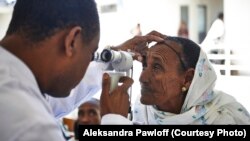Light for the World is dedicated to improving eye health for people in developing countries. The NGO has worked to eradicate trachoma, a preventable disease of the eye that is endemic in parts of Ethiopia. With project partners, the NGO also restores vision to people suffering from cataracts and glaucoma.
At the Quiha Eye Hospital Vision Center in Mekelle, Ethiopia you can see anticipation on the faces of patients young and old waiting their turn to see the eye doctor. Their ailments range from eye infections that could lead to disease, to those already displaying serious eye diseases such as cataracts and glaucoma.
In the center’s eye clinic, an optometrist examines their eyes,and explains what options they have for treatment. Nuaine Mohamed Hagos is a doctor at the eye clinic.
“From an optometrist, what they are expecting us to do in this hospital is first we do the refraction part. First, before we refract we just do the slit-lamp examination, all the steps done for refraction. But first we have to exclude the diseased parts, and we see with the slit-lamp if there are any diseases. We just treat the disease first before refraction. And then we do the refraction,” explained Hagos.
The slit-lamp device is a low-power microscope combined with a high-intensity light source that produces a thin beam of light. Dr. Nuaine Hagos sits one side of the device, the patient on the other. She asks the patient to rest his or her chin in a small cradle of the device and sit forward so her forehead presses against it.
Dr. Hagos examines the front of the eye, including the eyelids, cornea, and iris. She gives the patient eye drops to dilate their pupils. Then she re-examines the patient’s eyes with the slit lamp, this time with a small lens held close so she can see the back of the eye.
With the slit-lamp, Dr. Hagos can detect diseases such as macular degeneration, glaucoma, cataract and corneal injuries.
In addition, the optometrist uses a biometry device to obtain they eye’s vital statistics.
“Another thing pre-operatively, for cataract surgery is we do biometry, the A-scan biometry. We measure keratometry and the biometry, and then we send for appointment for cataract surgery,” the doctor described
Light For The World says cataracts are the leading cause of loss of sight for some 20 million people. A cataract causes cloudy or fuzzy vision, and may make its victim very sensitive to light, causing a glare in vision.
Old age is an important factor in cataracts, though some children are born with them. They can also occur after accidents or infections. .
Cataract surgeries are performed every day at the Quiha Eye Hospital Vision Center in Mekelle. They are done on an ‘outpatient’ basis, meaning that the patient goes home the same day as the operation. The patient receives a local anesthetic and the ophthalmologist -- or eye surgeon -- replaces the cloudy or opaque lens with a clear artificial lens in a 15-minte procedure. There is little risk, and the patient’s eye sight is greatly improved.
“Another thing is a visual field test for glaucoma patients. We do have the Tangent screen and the FTD. Especially, the FTD is a Goldmann-standard measurement, internationally,” said Hagos.
The Tangent screen or Goldmann field exam is used to determine a person’s field of vision. The patient sits about three feet from a screen with a target in the center. The doctor asks the patient to stare at the center object and let them know when the object moves into the patient’s side vision. This exam creates a map of the patient’s peripheral vision.
This exam is painless, and the doctor is able to determine whether there is loss of vision anywhere in the visual field. The pattern of vision loss will help the doctor diagnose the cause. Dr. Hagos performs this exam on many patients each day.
“Commonly, there is cataract a lot. There is also glaucoma. Nowadays, refractive errors…the awareness of the population is increasing and they’re coming to our clinic for refraction—refractive error is now common,” explained Hagos.
Her days at the eye center are busy, but she says it is satisfying.
“I really like optometry and I’m enjoying my work,” she said with a smile.
Light For The World reports that its project partners performed more than 55,000 cataract surgeries in 2013.
Another 15,100 eyelid surgeries have been done to help patients suffering from Trichaisis, which is the last stage of Trachoma.
In all, almost a million patients have been treated for eye diseases through Light for the World’s eye health programs, and more than a million others have received sight saving drugs through the group’s distribution program.








